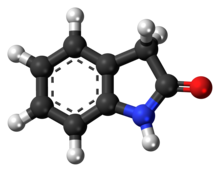Oxindol
 |
|
 |
|
| Names | |
|---|---|
|
Preferred IUPAC name
Oxindole
|
|
|
Systematic IUPAC name
1H-indol-2(3H)-one
|
|
| Identifiers | |
|
3D model (JSmol)
|
|
| 114692 | |
| ChEBI | |
| ChEMBL | |
| ChemSpider | |
| ECHA InfoCard | 100.000.390 |
| EC Number | 200-429-5 |
| 637057 | |
| KEGG | |
| MeSH | Oxindole |
|
PubChem CID
|
|
| RTECS number | NM2080500 |
| UNII | |
|
|
|
|
| Properties | |
| C8H7NO | |
| Molar mass | 133.15 g·mol−1 |
| Melting point | 128 °C (262 °F; 401 K) |
|
Except where otherwise noted, data are given for materials in their standard state (at 25 °C [77 °F], 100 kPa).
|
|
|
|
|
| Infobox references | |
Oxindole (2-indolone) is an aromatic heterocyclic organic compound. It has a bicyclic structure, consisting of a six-membered benzene ring fused to a five-membered nitrogen-containing ring. Oxindole is a modified indoline with a substituted carbonyl at the second position of the 5-member indoline ring.
Oxindole is a tryptophan derivative and in human biology is formed by gut bacteria ("normal flora"). It is normally metabolized and detoxified from the body by the liver. In excess, it can cause sedation, muscle weakness, hypotension, and coma. Patients with hepatic encephalopathy have been recorded to have elevated serum oxindole levels.
...
Wikipedia
